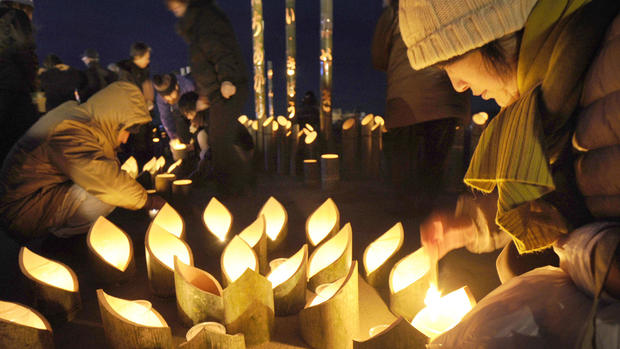The scar that a tsunami left on Japan
It was exactly one year ago today that Japan was struck by a disastrous earthquake and tsunami . . . and a nuclear meltdown followed. One year later we've asked our Bill Whitaker to take stock:
All along Japan's northern coast it's shocking to see the vast stretches of emptiness - a lifeless moonscape dotted with mountains of debris.
The only activity: Mechanical arms building heaps of debris higher and higher.
So much nothingness, one can't help but wonder what's been accomplished over the past year? ... until you remember how this all began.
The magnitude 9.0 earthquake, the worst ever recorded in Japan, might end up a footnote compared to the black tide it triggered. The tsunami swept in off the Pacific and laid waste to everything in its path.
A coastline of cities and towns, factories and farms washed away in an instant.
Ebisu, the god of good fortune and the sea, was no match. Almost 20,000 people died or still are missing. So much death and destruction it took this country - an economic and technological giant - a whole year to achieve what today looks like . . . nothing.
"There is so much debris, but it exceeds the capacity of these communities to get rid of it, to incinerate it, to dump it. So it has to go somewhere else. And other communities around Japan have not been raising their hands," said Jeff Kingston, who teaches Japanese history at Temple University Japan.
Japan marks somber anniversary of disaster
Children orphaned by tsunami struggle to cope
Parents look for answers year after Japan tsunami
Complete coverage: Disaster in Japan
"There are vague concerns about radiation, about asbestos - people are not sure," said Kingston, "and because there's these large piles of debris still there, a year later, reconstruction can't happen."
The tsunami left a scar on the land and on Japan's soul.
Every day for the past year at 2:46 p.m., the time of the earthquake, Hiromi Miura goes to the place where the waves took her husband Takeshi. She leaves his favorite sake and flowers. The couple met in 1st grade and thought they'd die together. Without him, she feels as though she HAS died.
Time has stopped for her, she said. She will never be cheered up. That's what she comes to tell her husband every day. That, and that she loves him.
If there was an epicenter to the tsunami horror it would be in Ishinomaki. Crews still search for 533 missing people; 3,182 died here, more than any other single place.
And no single place in this small city saw more death than the Okawa elementary school. It's now a shrine. People come daily, moved by the story of students who followed school guidelines and went outside to be safe from aftershocks. They were all lined up outside when the tsunami swept in. It carried 74 children and 10 teachers to their deaths.
A hill where they could have sought safety is right behind the school.
Sayomi Shito's 12-year-old daughter, Chisato, died at Okawa.
"Every day we'd touch cheeks," Sayomi told us. Chisato, her youngest, was the glue that held the family together.
One year later Sayomi is full of pain . . . and haunted by questions: "Was she scared? Was she waiting for me? Did she wear her jacket to keep warm?"
And the question that leaves her bitter: "Why did the school not protect her?" When angry parents confronted school officials, you can see on a home video the one teacher who survived the tsunami bowed his head in shame.
For many Japanese it's hard to not be angry at the Fukushima Dai-ichi nuclear plant. The ferocious force of the Earth unleashed a more fearsome one - a series of horrific events at the Fukushima Daiichi nuclear plant. Officials say the facility now is under control. But just last month we learned it came closer to total meltdown than anyone knew, except for a handful of government and company officials.
"Things have changed dramatically in how people view the government," said Kingston. "Trust in the powers-that-be has eroded dramatically, and this is unusual in Japan."
The government has launched a $235 billion, five-year recovery plan, but nobody who sees the wasteland - and certainly nobody who lives here - believes that's enough money or time to bring this region back.
Japan's recovery is too daunting, too immense for any one person to do much about.
But individual Japanese are having a big impact with little acts of kindness.
Shigeo Tomihari is one of a group of doll makers, making dolls for parents who've lost children in the tsunami.
After the harsh winter comes spring, he told us. You don't suffer the harsh winter forever. Spring will arrive. Wait for that day with this doll.
Sayomi Shito got one of the dolls. Her daughter, Chisato, loved Spring, when the cherry blossoms bloom.
But Sayomi can't see that promising future yet. Her eyes are too filled with tears.
